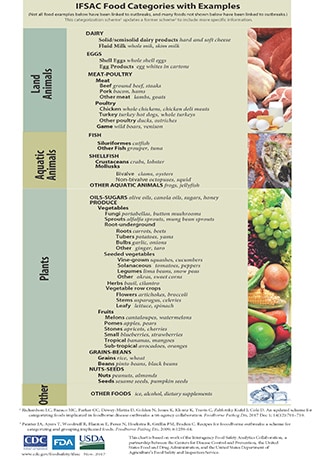At a glance
The IFSAC food categorization scheme has five distinct levels to which foods can be assigned, depending upon the type of food.
Food categorization
Foods are assigned to one of four food groups (aquatic animals, land animals, plants, and other) which include specific food categories. These foods are then differentiated by differences in food processing.
These documents are based on work of the Interagency Food Safety Analytics Collaboration, a partnership between the Centers for Disease Control and Prevention, the United States Food and Drug Administration, and the United States Department of Agriculture's Food Safety and Inspection Service.
- Richardson LC, Bazaco MC, Parker CC, Dewey-Mattia D, Golden N, Jones K, Klontz K, Travis C, Zablotsky Kufel J, Cole D. An updated scheme for categorizing foods implicated in foodborne disease outbreaks: a tri-agency collaboration. Foodborne Pathog Dis. 2017 Sep 19, ahead of print. Read the abstract.
- Painter JA, Ayers T, Woodruff R, Blanton E, Perez N, Hoekstra R, Griffin PM, Braden C. Recipes for foodborne outbreaks: a scheme for categorizing and grouping implicated foods. Foodborne Pathog Dis, 2009; 6:1259-64. Read the article.

